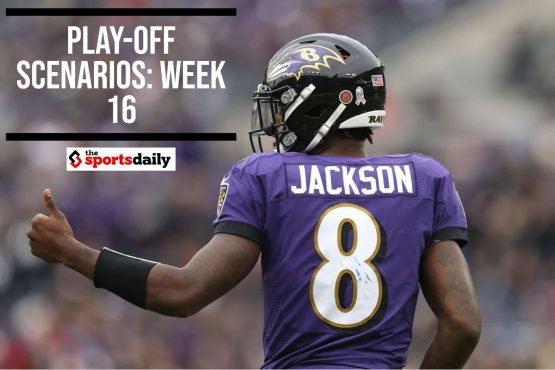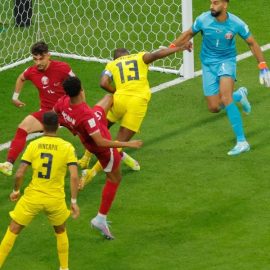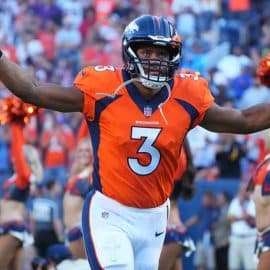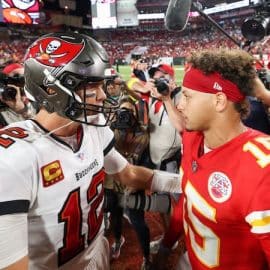With the NFL Combine less than a day away, we’ll take a look at each of the main drills and components of the Combine and why they can affect a prospects stock.
We’ll break down what each drill entails, what it shows about the prospect, and what you can expect to see come draft day.
Be sure to check out other articles coming soon about other things to expect from the combine.
Basic Drills (40 Yard Dash, Bench Press, and Vertical and Broad Jump)
These drills are the most notable of the activities done by a prospect to the casual fan. However, these are very raw showings of athletic ability aren’t really the main focus of the evaluation process at the combine now.
However, the 40 yard dash, more to ensure scouts of a prospects speed, still shows the prospects straight-line speed compared to the other prospects in the draft. This is particularly useful for evaluating running backs, receivers, cornerbacks, and safeties, and if any other position really exceeds the average times, it can help them as well.
The bench press, usually only done by running backs, linebackers, and lineman, shows the prospects strength and conditioning. 25+ for lineman is a good benchmark, while 10+ is expected for running back and linebackers.
Finally, the vertical and broad jump test for leg explosion. The vertical jump is starting flat footed and going straight up in the air, obviously needing a great deal of force to explode upward. The broad jump is very similar, except instead of going up, they’ll be going straight outwards. By showing this explosion, teams can see how high receivers can get up for jump balls, how a running back can explode from side to side, and how defensive players can explode through a tackle.
20 Yard (Short) and 60 Yard (Long) Shuttle
Both the short shuttle and long shuttle have the same change of direction concept.
In the 20 yard shuttle, the prospect goes right 5 yards, left 10 yards, and then back to the initial starting point 5 yards away. In the 60 yard shuttle, the prospect goes 5 yards, then back to the starting point, then 10 yards and back, and 15 yards and back for a total of 60 yards.
The short shuttle especially tests the change of direction and overall coordination of the prospect. By stopping at a point and accelerating back to the opposite direction, you can see how a player cuts in open field and how well he can react to his surroundings.
The long shuttle shows that as well, but throws in more of an endurance factor. By performing well here, a prospect can show that not only is he able to go sideline to sideline (for defenders), or whether he can maintain cutting ability long into games (running backs and receivers).
3 Cone Drill
As you’ll tell, most scouts are looking for explosion, quickness, and change of direction in these drills as a whole, and the 3 Cone drill is one that wraps up everything in one drill.
Three cones are in an “L” formation, each cone 5 yards apary. The prospect sprints from the base point of the L to the elbow, touches a line, and goes back to the starting. Then, he runs to the elbow, cuts around the outside, weaves through the top of the L, goes back around the elbow and finishes at his starting point.
By constantly moving quickly while having to cut at certain points and bend over all in one full sprint, scouts can breakdown this drill into many positions.
By seeing running backs run this drill, they can tell how he changes direction, his burst between cuts, and his body control as he bends over.
Receivers show some of the same running ability, especially showing how they can cut so they develop as route runners.
And defenders use this to show that they can be flexible as the play develops and still maintain quickness and speed as they cut to find the ball carrier.
Off-the Field (Measurements, Interviews, Wonderlic, Cybex Test, Injury Evaluation)
While the main show of the combine is the workouts, maybe the most crucial time at the NFL Combine for a prospect is off-the-field.
It starts with measurements, with height, weight, arm length and hand length. It’s always entertaining to see which top junior prospects “shrunk” since their college days, as many of the coaching staffs glorify a quarterback or receivers height on public depth charts.
The interviews are crucial. These 15 minute chats with the team can range from discussing past issues, breakdown plays to show understanding, and much more. Teams’ take this part very seriously and it’s usually entertaining yet intriguing to hear about what some of these teams are trying to find out about certain players.
The Wonderlic test gets a little too much hype, but it still is a useful tool. The test is designed not to be extremely difficult, but to be a logical reasoning test. The faster you can work through them, the quicker you are at breaking down situations, to an extent. It’s designed so many people don’t finish it, and rarely does a prospect get the perfect score of 40. Try a test out at www.wonderlic.com.
The Cybex Test and Injury Evaluation parts off the field are just to ensure that a player is in peak physical levels. The Cybex tests for flexibility in a prospect, crucial for limiting injuries. And, of course, teams want to be assured that a prospect they may draft doesn’t have any hidden injuries as well.
Other Notable Position Drills–Quarterbacks
The quarterback drills are mainly a way for each prospect to showcase his throw diversity.
Each prospect will work out of either a 3, 5, or 7 step drop. He will throw each of the routes on the basic “route tree”: a slant, an out, an in, a deep corner, and a go-route.
Scouts are looking to see how the ball is released from the prospects hand, and how the ball is projected into the air. Though not crucial, the better the spiral, the less concerns scouts have about the ball fluttering.
Also, scouts are looking at a quarterback’s footwork, his ability to read a receiver as he’s dropping back, and how well he plants and drives through the throw. Arm strength is somewhat of the golden standard for quarterbacks these days, and if these prospects have great arm strength, look for the drills to show that off.
Other Notable Position Drills–Receivers
Maybe the most well known name of a drill of any Combine position workout, the “Gauntlet” is a drill that NFL teams use as well in their off-season training. At the combine, the drill’s version goes like this.
First, the receiver catches a pass, drops the ball, spins around and catches another and drops it. Then, he has to run along a straight line and catch five passes from quarterbacks as he’s running full speed across the field, with the throws alternating on opposite sides of him.
This drills shows off a few things for a receiver. One, it shows concentration. These receivers need to look the ball in very quickly, and then move on to a different target for a total of seven balls. That takes a lot of focus.
Also, it shows how well a receiver can maintain his body and speed as he runs in as perfect of a straight-line as he can without losing focus on the ball.
Finally, it shows pass catching ability, the drill is designed to show how well a receiver can catch with his hands only, as the receiver doesn’t have time for the ball to come into his body before the next ball is coming.
Other Notable Position Drills—Offensive Linemen
As the league develops into a more pass-happy league and quarterbacks begin to consistently get in the 10 million dollar a year area, teams are going to put a higher premium on capable left tackles with pass blocking ability.
Well, this is the drill to showcase how well a prospect can do at that skill. Most teams employ either a 3-4 or have a situational pass rushing scheme in a 4-3. In both cases, the offensive tackle needs to slide outside and contain the pass rushers speed while not losing balance or strength.
The lineman will get in a two or three point stance, open up at a 45 degree angle, and slide along and follow the defender outside of the cone that is 12 yards behind the start of the play and is mimicking where the quarterback would be.
By keeping their balance, maintaining their base, displaying a natural bend in their knees, and still showing power, an offensive tackle can make a lot of money performing well in this drill.
Other Notable Position Drills–Linebackers
As said before, as the league becomes a more pass happy league, both offensive and defensive schemers will have to invent new ways to outdo each other.
The main pass defense drill that linebackers run at the combine is a basic pass drop and hip rotation drill. First, the linebacker starts in a backpedal, following the coaches ball as he mimics a quarterback. He’ll follow the ball in the coach’s hand left or right. When the coach brings the ball down, that indicates underneath pass and he has to plant, pivot, and sprint towards the coach to “pick off’ the pass.
This drill shows how natural of a runner these linebackers are and how well they keep their hips low while in the open field. By showing good hip fluidity, a linebacker can really show off his diverse ability to play in multiple systems.
Add The Sports Daily to your Google News Feed!







